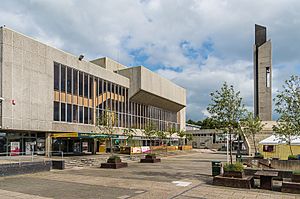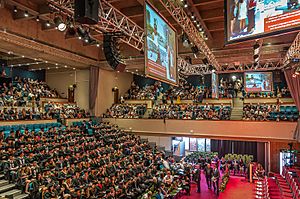Aberystwyth Arts Centre facts for kids
 |
|
| Lua error in Module:Location_map at line 420: attempt to index field 'wikibase' (a nil value). | |
| Established | 1970 |
|---|---|
| Location | Aberystwyth, Ceredigion, Wales |
| Type | Arts centre |
| Architect | Great Hall – Dale Owen of Percy Thomas Partnership Redevelopment – Peter Roberts Studio complex – Thomas Heatherwick |
The Aberystwyth Arts Centre (called Canolfan y Celfyddydau Aberystwyth in Welsh) is a big arts center in Wales. You can find it on the Aberystwyth University campus. It's one of the largest arts centers in Wales! It has a theatre, a concert hall, a studio, and a cinema. There are also four art galleries, cafés, bars, and shops for visitors.
Contents
History of the Arts Centre
How the Arts Centre Started
The University College of Wales, Aberystwyth started building the Arts Centre in the 1960s. It was meant for the university, the town of Aberystwyth, and nearby areas.
The first part to open was the concert hall, called the Great Hall, in 1970. Dale Owen designed it. This building won important awards for its design. The theatre, called 'Theatr y Werin' (meaning 'theatre of the people'), was finished in 1972.
From the very beginning, the Arts Centre welcomed many different types of shows. It supported local groups and university performers. It also invited famous professional companies. The university, the Arts Council of Wales, and the West Wales Association for the Arts have always supported the center.
Roger Tomlinson was the first manager. He led the center from its planning stages until 1975. He brought in shows with well-known actors like Pete Postlethwaite and Julie Walters.
Ken Williams became the manager in 1975. He loved classical music. He helped create the musical shows that are still popular today. Michael Ball first performed professionally in the center's 1985 show Godspell.
The art exhibitions grew a lot after Alan Hewson joined in 1978. He started the Arts Centre Café in 1980 and the Bookshop in 1981. He also began showing films in 1983. He created art education programs for the community.
Growing Bigger: 1984-2013
Alan Hewson became the Director in 1984. In 1985, the Arts Council of Wales changed its funding. The Arts Centre needed to find new ways to get money for its programs.
They came up with three main ideas. First, they would work with others on artistic programs. Second, they would connect more with the community through art programs. Third, they would earn more money from their shops and cafés.
Festivals became a great way to bring in audiences. The Musicfest International Music Festival started in 1986. It now has over 30 concerts each year. About 100 young musicians from all over the world attend its Summer School.
The International Ceramics Festival began in 1987. It brings over 1,000 potters and ceramic artists from around the world. The university already had a collection of modern ceramics. The festival helped connect people to this art.
Over the next 20 years, the Arts Centre helped start many more festivals. These included festivals for children's books, poetry, and theatre for young people. There were also festivals for world music, world cinema, and photography. These festivals help support the work of the university departments.
The community art and education programs started in 1984. They now cover many art forms and earn much of their own funding. The center also grew its commercial side. This was helped by funding in 1993 and 2000.
Through the 1980s and 1990s, the center added workshops, studios, cafés, and shops. These helped meet demand and fund the art programs.
A big project costing £4.3 million opened in 2000. It added a new art gallery, workshops, a cinema, and dance studios. It also made the theatre entrance much bigger. This project won an award from the Royal Institute of British Architects.
In 2009, a new studio complex for artists was finished. It cost £1.25 million. This complex also won important awards. It hosts artists from the UK and other countries.
Alan Hewson left in 2013 after 28 years. He was praised for making the Aberystwyth Arts Centre one of the most successful art centers in the UK.
Recent Years: From 2013 to Today
The Arts Centre closed in March 2020 because of the Covid-19 pandemic. It also needed repairs from bad weather. It reopened in July 2021. Dafydd Rhys was the Director until December 2022. During his time, the Arts Centre became a top place for arts in West Wales again.
In summer 2021, the center showed a special art exhibition. It featured 550 artworks made during the lockdown periods. These were created by 148 different artists.
In summer 2022, the National Eisteddfod returned to Tregaron. The Arts Centre presented two related events. A show of Ogwyn Davies' art was in the main gallery. A play called "Operation Julie" was performed in Theatr y Werin.
In February 2023, David Wilson was announced as the new director.
In 2024, the Great Hall was given a special Grade II* listing. The bell tower and Hugh Owen Building also received Grade II listings. All three buildings had won architectural awards before.
How the Arts Centre is Funded
The Arts Centre earns almost £3.5 million each year. About 78% of this comes from ticket sales and its shops, cafés, and conferences. This is a very high amount compared to other art places in the UK.
It gets money from the University, the Arts Council of Wales, and Ceredigion County Council. The Arts Centre now receives over £500,000 a year from the Arts Council of Wales. It has also received almost £3 million for big building projects in the last ten years.
Places to Visit at the Arts Centre
The Arts Centre is open every day of the year. It offers many shows like theatre, dance, music, and films. You can also take art classes. In the summer, there are festivals and big theatre shows. These attract both local people and tourists.
The Theatre
The theatre has 312 seats. It shows both professional and local community plays. Some shows made at the center also go on tour. The program includes plays, dance, opera, comedy, and musicals. There is a family show at Christmas and a traditional pantomime. A special summer show runs for five weeks in July and August.
The Arts Centre has a youth theatre program. Some members have gone on to become professional actors. Taron Egerton and Gwyneth Keyworth both studied at RADA after being in the youth theatre. They performed together in Little Shop of Horrors in 2007.
The Studio
The Studio can seat up to 80 people. It's a smaller, more cozy space. It's used for new and experimental plays and book readings. The "Open Platform" program helps new artists show their work.
The Concert Hall
The Great Hall has 1250 seats. It hosts music concerts, theatre shows, and university events like graduation ceremonies. It can also be used for trade shows, conferences, and weddings. These events help the Arts Centre earn money.
The Cinema
The cinema has 112 seats. It shows Hollywood movies, foreign films, and classic movies. At least two films are shown every day. There are also special screenings for parents with babies. The cinema uses modern technology for great sound and picture. It also shows live performances from famous opera and ballet companies. It hosts film festivals like the Abertoir festival.
Art Galleries
Gallery 1 is the main space for art exhibitions. It shows modern art like paintings, sculptures, and digital art. Gallery 2 focuses on prints and photographs. The Ceramics Gallery displays pottery from around the world. It also holds the Aberystwyth University Ceramics Collection. The Café Gallery shows smaller artworks in a relaxed setting. There is also 'The Eye', a small space for watching artists' films.
Workshop Spaces
The Arts Centre has many workshop spaces for its community art programs. These include four dance studios, a ceramic studio, and a recording studio. There is also a photography studio. These spaces help students, staff, and the local community learn and create art. People are encouraged to show their skills in public performances and exhibitions.
Cafés and Bars
The center has three places to eat and drink. There's the main Café, which includes the Café Gallery. The Piazza Café is outside on the plaza. The Theatre Bar is next to Theatr Y Werin.
Shops
The Craft and Design shop sells modern crafts and jewelry. It often features work from Wales. It also holds a Craft Fair in November and December. The bookshop sells books, including academic ones. It also hosts book launches and literary events.
Arts Centre Facts and Figures
Before the pandemic, the Arts Centre welcomed over 650,000 visitors each year. It held over 700 events. About 100,000 people took part in its community arts and education programs. With earnings of about £3.5 million, the Arts Centre is known as one of the most successful art centers in Wales.



